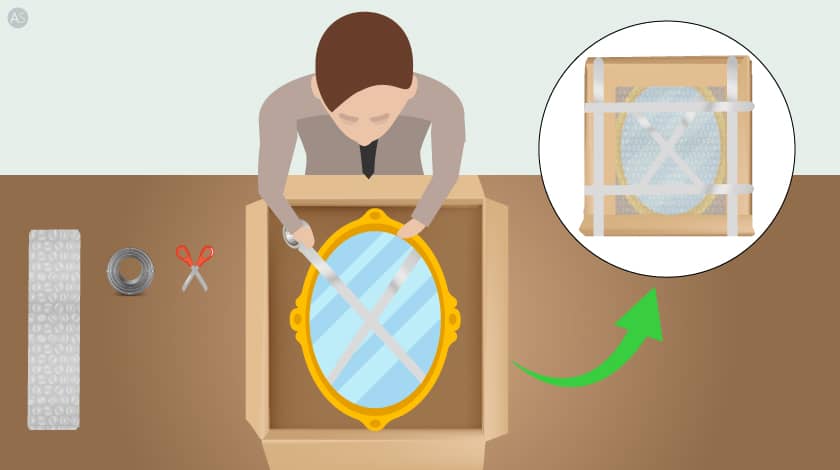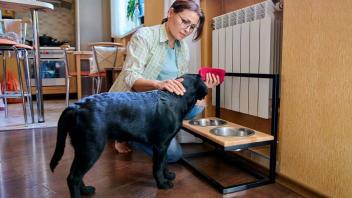A Guide to Packing and Moving Mirrors Safely

Transporting fragile items like mirrors while relocating from one place to another demands extra care and attention. Mirrors, being delicate and often valuable, require proper packing and handling to ensure they reach their destination in perfect condition.
In this blog, we will walk you through the process of packing and moving mirrors safely to your new home.
{"preview_thumbnail":"/sites/default/files/styles/video_embed_wysiwyg_preview/public/video_thumbnails/6X1jdmWAsA8.jpg?itok=MHlrlTMb","video_url":"https://youtu.be/6X1jdmWAsA8","settings":{"responsive":1,"width":"854","height":"480","autoplay":1},"settings_summary":["Embedded Video (Responsive, autoplaying)."]}
Preparing Mirrors for the Move
A. Assessing Your Mirror Collection
Before packing, it's crucial to take a thorough inventory of your mirror collection. This will help you determine the right packing materials and techniques needed for each type of mirror.
1. Types of Mirrors
-
Wall mirrors: Mirrors that are designed to hang on the wall, either framed or frameless. They come in various shapes and sizes.
-
Floor mirrors: Large, full-length mirrors that typically lean against a wall or stand on their own, often used for dressing purposes.
-
Vanity mirrors: Mirrors that are attached to or placed on a vanity table, usually accompanied by small lights or a stand.
-
Decorative mirrors: Mirrors that serve primarily as decorative elements, such as sunburst mirrors, mirror wall art, or mirrors with intricate frames.
2. Size and Weight Considerations
Take note of the size and weight of your mirrors, as this will influence your packing materials and techniques. Large or heavy mirrors may need additional support and reinforcement during packing and transportation.
B. Gathering Necessary Packing Materials
Gather the essential packing materials to ensure your mirrors are well-protected during the move. Here's a list of recommended materials:
-
Bubble wrap: To provide cushioning and protect the mirror surface from scratches and damage.
-
Packing paper: To wrap the mirror and provide an additional layer of protection. Use acid-free packing paper for antique or delicate mirrors.
-
Corrugated cardboard sheets: To provide extra support and protection for the mirror glass.
-
Packing tape: To secure the packing materials in place and reinforce the edges of the mirror.
-
Moving blankets: To wrap and protect large or heavy mirrors during transportation.
-
Sturdy boxes or mirror cartons: To securely contain the packed mirrors. Choose boxes with dimensions slightly larger than your mirrors to allow for proper padding.
-
Corner protectors: To safeguard the corners of framed mirrors from dents or damage.
-
Marker for labeling: To clearly label your packed mirrors with details such as "Fragile," "Mirror," and the designated room in your new home.
Packing the Mirrors
Step 1: Prepare Your Mirror
-
Place the mirror on a clean surface, such as a dining table or on a clean floor.
-
Lay your mirror face-up and draw a giant "X" with painter's tape across the face of the mirror from corner to corner.
-
You can run the tape horizontally and vertically along the reflective surface in a grid pattern which will significantly increase the protected area.
Note: This "X" or grid pattern method is simply a protective measure for added protection.
Step 2: Pack Your Mirror
-
Use a foam or cardboard corner protector to affix the corners of the mirror before you start wrapping it.
-
Cover the entire mirror surface with packing paper and secure it with tape.
-
Wrap the mirror in bubble wrap, making sure at least two layers cover the whole surface, and secure with packing tape.
-
Place cardboard on the sides of the mirror as a protective shield to absorb any impact and keep the mirror from bending. Tape the cardboard to the mirror with packing tape.
-
Crumple a few packing papers, and create a bed of padding on the bottom of your mirror box.
-
Gently slide the wrapped mirror inside the box and cover any empty places with crumpled packing paper or packing peanuts. Make sure there is no empty space in the box since this can cause the mirror to shift and possibly break during transit.
-
Tape up the box and gently shake it to see if anything moves. If it does, open the box and add additional padding.
-
The final step is to secure your mirror box using packing tape. Label each side of the box with "FRAGILE" and "DO NOT LAY FLAT" using a permanent marker.
Also read: Tips for Packing Fragile and Valuable Items
Loading Mirrors into the Moving Vehicle
Proper positioning, orientation, and security procedures are required to guarantee that your mirrors arrive at your new house undamaged. Follow these simple steps to load your packaged mirrors into moving carriers.
A. Proper Placement and Orientation
-
Load mirrors vertically: Place mirrors in an upright, vertical position. This orientation helps distribute the weight evenly, reducing the risk of breakage.
-
Avoid stacking: Do not stack mirrors on top of each other or place heavy items on top of mirror boxes. This can cause pressure on the glass and increase the risk of damage.
-
Place mirrors between stable items: To further protect your mirrors, place them between stable, sturdy items such as mattresses, bookshelves, or large furniture pieces. This can help prevent the mirrors from shifting or falling during transit.
B. Securing Mirrors to Prevent Movement
-
Use moving straps or ropes: Secure your mirrors to the vehicle's side rails or other anchor points using moving straps or ropes. This will help keep the mirrors in place and prevent them from sliding or falling.
-
Fill gaps with padding materials: If there are any gaps between your mirrors and other items in the moving vehicle, fill them with padding materials such as moving blankets, bubble wrap, or crumpled packing paper. This will help prevent movement and absorb any shocks during transit.
-
Check for stability: Before closing the moving vehicle, double-check that all mirrors are stable and secure. Give them a gentle shake to ensure they don't shift easily.
C. Using Moving Blankets and Padding for Extra Protection
-
Wrap large mirrors in moving blankets: Wrap large or heavy mirrors in moving blankets for added cushioning and protection.
-
Place padding materials around mirrors: To further protect your mirrors, place additional padding materials such as bubble wrap or packing paper around them in the moving vehicle. This can help absorb shocks and reduce the risk of damage during transit.
Unpacking and Setting Up Mirrors
Once you've arrived at your new home, it's time to unpack and set up your mirrors. Follow these steps:
-
Choose a clean, soft surface to place the mirror to prevent scratches or damage.
-
Carefully cut or peel off the packing tape and remove the packing materials, taking care not to scratch or damage the mirror's surface or frame.
-
Inspect your mirrors for any damages that may have occurred during the move.
-
If your mirror has a frame, check it for any dents, scratches, or other damages.
-
Document any damages by taking photos for insurance purposes, if necessary.
-
Select a spot on the wall or vanity table that can support the weight and size of the mirror.
-
If you're hanging a wall mirror, install the appropriate mounting hardware, such as brackets, anchors, or hooks. For vanity mirrors, reattach them to the vanity table following the manufacturer's instructions, if available.
Conclusion
By following these simple steps, you can ensure that your mirrors are protected during the moving process. While it may take a little extra time to properly pack a mirror, it's well worth the effort to prevent damage and save yourself the headache of replacing a broken one. With the right packing materials and a little care, your mirrors can arrive at your new home in one piece and ready to be hung on the wall.
If you don't want to invest time and effort in this packing process, you can easily hire a professional mover as they are experienced and equipped well enough to handle any type of relocation without causing any damage to your fragile goods.











